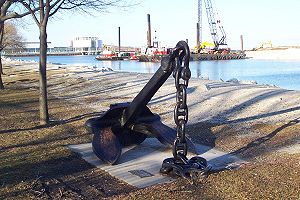SS Milwaukee
The SS Milwaukee was a train ferry that served on Lake Michigan. It was launched in 1902 and sank with all hands off Milwaukee on 22 October 1929. 52 men were lost with the vessel.
Contents
On the Milwaukee run: 1908–1929
The Milwaukee shuttled railroad cars back and forth from Milwaukee to the Grand Trunk Railway's dock in Grand Haven in western Michigan. This route enabled shippers to avoid the crowded railroad yards and sidings of Chicago. The Milwaukee was home-ported in the city for which it was named. The docks of the Grand Trunk Milwaukee Car Ferry Company were located on the Kinnickinnic River, and their ferries were familiar sights to residents of Jones Island.
October, 1929
Shortly before 2:00 pm on 21 October 1929, the Milwaukee sailed off on Lake Michigan into a storm bound for Grand Haven, and was lost. The Milwaukee was last seen passing by U.S. Lightship 95 (LV-95/WAL-519), a ship anchored three miles offshore, serving as a lighthouse. The Milwaukee was reported to be pitching and rolling heavily as it disappeared into the rainy mist. The ship did not have radio equipment. It was considered routine for the Milwaukee to challenge the storm. The theory is that its cargo of 25–27 railroad cars came loose in the 37 mph (32 kn; 60 km/h) gale and crashed through the sea gate, allowing water to come in over the stern and sink her. The captain, Robert H. McKay, apparently turned back for Milwaukee, but never made it.
On 24 October, aircraft searched Lake Michigan, but found nothing.
Some of the lifeboats were launched by the crew, and the bodies of two crew members wearing SS Milwaukee lifejackets were picked up two days later by the steamer, SS Steel Chemist, off Kenosha, Wisconsin. A lifeboat containing four dead crew members was found floating near Holland, Michigan, on the other side of the lake.
On 27 October, an empty lifeboat was found floating near Grand Haven, Michigan. On further investigation, it was found that the ship's message case was floating nearby with an apparent final message: Oct. 22, 1929. 8:30 pm. The ship is making water fast. We have turned around and headed for Milwaukee. Pumps are working, but sea gate is bent in and can't keep the water out. Flicker is flooded. Seas are tremendous. Things look bad. Crew roll is about the same as last payday. A.R. Sadon, Purser.[1]
All 52 people on board were lost, but only six bodies were recovered. As the years passed, interest in the circumstances around the loss of the ship was occasionally rekindled. For example, the story was retold by marine historian Dwight Boyer in his Ghost Ships of the Great Lakes in 1968.[2]
City of Milwaukee
As a result of the loss of the SS Milwaukee, the Grand Trunk needed a new train ferry. The replacement was the SS City of Milwaukee, launched 25 November 1930. The replacement vessel is now a museum ship and National Historic Landmark. Its website can be found at http://www.carferry.com/ The City of Milwaukee is the last traditional steamer-type railroad ferry and is worth a visit to get an idea of what sailing aboard the SS Milwaukee was like.
The train ferry rediscovered: 1972 to present
In April, 1972, the wreck was located in Lake Michigan, seven miles northeast of Milwaukee, Wisconsin, three miles offshore (on a line between Milwaukee and Grand Haven), at 43°08′11″N 87°49′55″W / 43.13639°N 87.83194°W[3], in 90 to 120 ffw.
In March 2006, the television program Deep Sea Detectives on the History Channel premiered an episode entitled "Train Wreck of Lake Michigan" which profiled the loss of the Milwaukee through historical documents, interviews with historians and dives on the wreck itself. The show highlighted the fact that there were missing hatch covers between the track deck and compartments below, including the engine room and the crew quarters (Flicker), that probably allowed those areas to become flooded and thus was a contributing factor to the sinking of the ship.
Statistics
- Built: Cleveland, Ohio; launched late 6 December 1902
- Length: 338 feet
- Beam: 56 feet
External links
References
- ↑ "Message in a Bottle". Michigan History 91 (2): 40–47. Mar/Apr 2007.
- ↑ Dwight Boyer (1968). Ghost Ships of the Great Lakes. New York City, N.Y.: Dodd, Mead & Company. LOC #68-23094.
- ↑ [1] Website viewed 19 August 2008.

